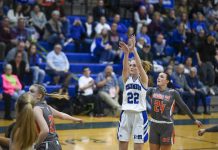One factor every athlete has to consider when deciding to play sport is the risk of injuries.
Whether the injury is minor or major, it is out of the players’ control most of the time.
One recommendation doctors have for athletes is trying to tackle multiple sports. Multi-sport athletes are less likely to become injured than ones who play a single sport.
According to a study commissioned by the National Federation of State High School Associations and conducted by researchers from the University of Wisconsin, high school athletes who specialize in a single sport are 70 percent more likely to suffer an injury during their playing season than those who play multiple sports.
[sc:text-divider text-divider-title=”Story continues below gallery” ]Click here to purchase photos from this gallery
Not a lot of correlation of increases in injury exist when athletes transition from fall to winter or winter to spring sports, but it is more about having more muscles involved and making the proper adjustments when moving from sport to sport.
“There’s nothing out of the ordinary, but I would be like to see them have a little rest between seasons just to give their own body a rest,” said Steve Souder, who has been an athletic trainer at Columbus North the past four decades. “For example, going from cross-country or soccer into swimming and in cross-country or soccer, you’re using mostly using your legs. But you when you get in the water, you’re using your arms and your legs and that’s some of the transition athletes go through.”
Single-sport athletes will clearly focus on that sport and master its skills to the highest degree, but there is also a drawback — burnout.
Athletes who spend time doing the same repetition over and over tend to quit or give up due to boredom or fatigue. They are also at a bit of a higher risk for injury.
“With single-sport athletes, it’s the same muscles over and over again,” Columbus East athletic trainer McKensie Vanosdol said. “Whereas a soccer player that transitions to swimming, they go from a lot of lower-body use to using upper- and lower-body use.”
While it is true that multi-sport athletes will equally distribute the use of their muscles throughout the body and it gives a little bit lower risk of a huge injury, they’ll less likely experience burnout on any particular sport. The big drawback with that is when the time comes to decide which sport to play in high school or college. Athletes may fear they choose the wrong sport to pursue when knowingly they excel at other sports.
Many experts suggest specializing in multiple sports at a young age before opting into single-sport specialization.
A study by the American Orthopedic Society for Sports Medicine in July 2017 found that specialization does not appear to increase a youth athlete’s chance of eventually achieving elite status in their sport.
Dr. Cary Guse at Southern Indiana Orthopedics, also the team doctor for East and North, recommends youth playing different sports at an early age before specializing at a later age.
A player Guse recalled was former East football standout and current Purdue running back Markell Jones. Jones was a soccer player in his youth and the crossover to football in high school as a running back helped him garner success.
“There are a lot of things that cross over very well,” Guse said. “A lot of sports feed off of each other and use different muscle sets. Complementary sports can be very helpful in development so that you can improve hand and eye coordination in multiple aspects.”
North junior Olivia Morlok, who participates in cross-country, swimming and track, says she likes running and swimming equally. She started swimming when she was 8 years old and started running when she was in seventh grade for the Northside Middle School team.
Morlok has suffered four different stress fractures from running the past three years. She says that staying in good shape by alternating with swimming during the summer and winter and running in the fall and spring also helps her get into cardiovascular shape to make the transition with her legs much smoother.
“If I spent my whole year running, I would definitely be a lot more injured because swimming has less impact,” Morlok said. “I think that swimming all winter really helps me when I come back for track in the spring to be less injured because I’ve been off my legs for a few months.”
East senior Jacob Bolte, who participates in football and wrestling, says the training in the weight room helps keep his muscles in shape.
“Using different muscles helps. There’s a definite grind to it,” said Bolte, who recently committed to wrestle at Purdue. “You’re going to get your bumps and bruises. We do a great job in our weight room working on preventing injuries.”
Guse said that giving your body as much as rest as possible can also make the transition to different sports less stressful.
“It’s hard to turn off the switch if you are going to transition. But if you can take a week or two away just to give your body a chance to recover and relax, that’s always a good thing,” Guse said. “I tell everybody that God rests on Sunday, and there’s no reason an athlete can’t rest on Sunday. You just have to prepare your body in a slow and gradual way, as opposed to suddenly turning the light switch on and going at a high velocity, high speed and high impact with the transition time.”
A couple of the most notable professional players that were multi-sport athletes in high school are NBA basketball star LeBron James and NFL football star Russell Wilson. Neither one have developed any significant injuries in their professional careers.
In the 2017 NFL Draft, 90 percent of the draft picks and 30 of the 32 first round draft picks were multi-sport athletes in high school.
While studies and doctor recommendations recommend doing multiple sports, there is no right or wrong approach to take in deciding whether to tackle multiple sports or just a single sport. It’s just one of the many factors that weighs on an athlete’s mind. In the end, it is up to the athlete to decide which path is best for them.
[sc:pullout-title pullout-title=”By the numbers” ][sc:pullout-text-begin]
In a study done by the National Federation of State High School Associations (NFHS) that surveyed 1,500 male and female athletes, lower-extremity injuries happen nearly twice as much (46 percent) to single-sport participants compared to multi-sport athletes (24 percent).
[sc:pullout-text-end][sc:pullout-title pullout-title=”Pull Quote” ][sc:pullout-text-begin]
"There are a lot of things that cross over very well. A lot of sports feed off of each other and use different muscle sets. Complementary sports can be very helpful in development so that you can improve hand and eye coordination in multiple aspects." — Columbus East and Columbus North team doctor Cary Guse
[sc:pullout-text-end]




